An Experimental Study of Nailed Soil Slope Models: Effects of Building Foundation and Soil Characteristics
Abstract
:1. Introduction
2. Laboratory Models
2.1. Simulation and Dimensional Analysis
2.2. Materials, Testing Tank and Loading Frame
2.3. Experimental Program
2.3.1. Preparation of Sand Filled Tank with Reinforcement
- The 150 mm thick first layer of the sand is formed using the sand spreader and leveled as desired to obtain the required predetermined density.
- The bottom layer nails with tubes are fixed in their positions.
- Then, the second layer is formed, and the layer is compacted to reach the required density.
- In each layer, the horizontal and vertical pressure cells were installed in their predetermined positions.
- Steps No. 2, 3, 4, were repeated until the tank is filled up and ready to begin the test.
2.3.2. Preparation of Sequence of Construction Phases
- The 140 mm thick layer of sand was excavated.
- The first facing panel is placed that includes pressure cells in line with the middle of the panel, and this facing panel is held with two polyethylene strips (sticky tape) to the box side to prevent sand from dropping from the gap between the edges of the slope facing and the box sides.
- Then, the installation of the first row of strain gauge fitted nails is carried out, which is tightened to the slope facing with nuts by pushing the nail into the sand. These nails are placed in their position using the tubes (black lines in Figure 2).
- Dial gauges are fitted to record the displacements of the slope facing due to excavation of the second layer.
- Another four layers of the sand, each 140 mm thick, are dug, and the facing panels are placed as before. At the third and fifth layers, a row of nails and pressure cells are fitted. The facing panel details are shown in Figure 1.
- In each stage, displacement of the slope face, tensile force in the nails and pressure (horizontal and vertical) are recorded.
- As the excavations are complete to a depth of 700 mm, the rigid footing was placed at the required location from the nailed slope crest at the top surface, leveled by a water bulb level and then loaded to the required pressure. The different stages of nailed soil slope constructed are depicted in Figure 2.
- The settlement of the footing is measured using LVDTs.
- The strain gauge reading is recorded simultaneously with the LVDTs and pressure cells for each foundation pressure case. The spreading of pressure in the nailed soil, horizontal stresses on the slope facing and the horizontal pressure behind the nailed soil are measured by means of five soil pressure transducers and six miniature strain gauge cells, namely, local cell pressure transducers.
3. Results and Discussion
3.1. Effect of Soil Type
3.1.1. Horizontal Movement of the Soil Nailing Slope
3.1.2. Settlement of the Footing
3.1.3. Force in the Nail
3.1.4. Vertical Pressure under Nailed Soil Mass
3.1.5. Horizontal Stresses on the Slope Face
3.1.6. Horizontal and Vertical Stresses behind Reinforced Soil Mass
3.2. Inclination of the Soil Slope
3.2.1. Horizontal Movement of the Nailing Slope
3.2.2. Settlement of the Footing
3.2.3. Force in the Nail
3.2.4. Horizontal Stress on the Slope Face
3.2.5. Vertical Pressure under Nailed Soil Mass
3.2.6. Horizontal and Vertical Stresses behind Nailed Soil Mass
3.3. Width of the Footing
3.3.1. Lateral Displacement of the Soil-Nailed Slope
3.3.2. Settlement of the Footing
3.3.3. Force in the Nail
3.3.4. Horizontal Stresses on the Slope Face
3.3.5. Vertical Pressure under the Nailed Soil Mass
3.3.6. Horizontal and Vertical Stresses behind Nailed Soil Mass
3.4. Footing Position from Slope Face
3.4.1. Horizontal Displacement of the Soil Nailing Slope
3.4.2. Settlement of the Footing
3.4.3. Force in the Nail
3.4.4. Horizontal Stresses on the Slope Face
3.4.5. Vertical Pressure under Nailed Soil Mass
3.4.6. Horizontal and Vertical Stresses behind Nailed Soil Mass
4. Numerical Modelling: Validation
5. Conclusions
- The maximum lateral displacement and slope face horizontal pressures occur in the middle third and minimum lateral displacement, and slope face horizontal pressures occur in the lower third of slope with different soil and footing parameters under various footing pressures.
- The lateral movement of slope and footing settlements reduces with an increase of soil density and decreases with an inclination of soil slope. The increase in footing width increases the slope face displacement and footing settlement. The increase in strip footing distance from slope crest reduces the slope face displacement and footing settlement.
- The vertical and horizontal pressures behind the soil mass are unaffected during the construction process but begin to increase with the increase in the footing pressure. The distribution of vertical stress under the soil mass away from the slope part remains constant during various construction stages, and under different loading stages, the vertical stress under the soil mass is increased with an increase in foundation pressure.
- A decrease in soil density leads to an increase in maximum tensile force mobilized in the nails. Increasing the soil slope results in increasing the maximum tensile force of nails at the middle third of the soil slope, while soil slope increase results in a decrease in the maximum tensile force of nails at the lower and upper third of the soil slope. The mobilized tensile forces in nails are increased due to an increase in soil density and a decrease in footing distance from the slope face.
- The horizontal stresses at the slope face decrease with the decrease of relative density of soil while they are increased due to an increase in soil slope angle. The horizontal stresses at the slope face increase with the increase of footing width and decrease of footing distance from the slope crest.
- The vertical stress under the soil mass is more in high slope soil, denser soil, larger footing and greater distance from slop. The increase in soil density and slope angle results in an increase in vertical stress behind the soil mass and a decrease in the horizontal stress behind the soil mass with the increase of soil density and slope angle.
- Increasing the footing width leads to an increase in the vertical and horizontal stress behind the soil mass. The vertical and horizontal stresses behind the soil mass decrease with the decrease of footing distance from the slope crest.
Author Contributions
Funding
Institutional Review Board Statement
Informed Consent Statement
Acknowledgments
Conflicts of Interest
References
- Pourghasemi, H.R.; Yansari, Z.T.; Panagos, P.; Pradhan, B. Analysis and evaluation of land slide susceptibility: A review on articles published during 2005–2016 (periods of 2005–2012 and 2013–2016). Arab. J. Geosci. 2018, 11, 193. [Google Scholar] [CrossRef]
- Sharma, M.; Samanta, M.; Sarkar, S. Soil Nailing: An Effective Slope Stabilization Technique. Landslides: Theory, Practice and Modelling. In Advances in Natural and Technological Hazards Research; Pradhan, S., Vishal, V., Singh, T., Eds.; Springer: Cham, Switzerland, 2019; Volume 50. [Google Scholar]
- Yelti, N. Analysis and Design of Soil Nail Walls in High Plasticity Clays. Master’s Thesis, Texas Tech University, Lubbock, TX, USA, 2011. [Google Scholar]
- Sanvitale, N.; Simonini, P.; Bisson, A.; Cola, S. Role of the facing on the behavior of soil-nailed slopes under surcharge loading. In Proceedings of the 18th International Conference on Soil Mechanics and Geotechnical Engineering, Technical Committee 207, Paris, France, 2–6 September 2013; pp. 2019–2094. [Google Scholar]
- Bridges, C.A.; Kizil, M.; Winter, M.G.; Smith, D.M.; Eldred, P.J.L.; Toll, D.G. The determination of deformation of soil nailed structures by a simplified method. In Geotechnical Engineering for Infrastructure and Development, Proceedings of the XVI European Conference on Soil Mechanics and Geotechnical Engineering, Edinburgh, UK, 13–17 October 2015; ICE: London, UK, 2015; pp. 913–918. [Google Scholar]
- Kotake, N.; Sato, E. Bearing capacity of a flexible plastic plate for soil nailing. Int. J. Phys. Model. Geotech. 2021, 21, 26–39. [Google Scholar] [CrossRef]
- Ceccato, F.; Bisson, A.; Cola, S. Large displacement numerical study of 3D plate anchors. Eur. J. Environ. Civ. Eng. 2020, 24, 520–538. [Google Scholar] [CrossRef]
- Sahoo, S.; Manna, B.; Sharma, K. Shaking Table Tests to Evaluate the Seismic Performance of Soil Nailing Stabilized Embankments. Int. J. Geomech. 2021, 21, 04021036. [Google Scholar] [CrossRef]
- Deng, D.-G.; Li, L.; Zhao, L.-H. Stability analysis of slopes reinforced with anchor cables and optimal design of anchor cable parameters. Eur. J. Environ. Civ. Eng. 2019, 1–16. [Google Scholar] [CrossRef]
- Mohamed, M.H.; Ahmed, M.; Mallick, J.; Hoa, P.V. An Experimental Study of a Nailed Soil Slope: Effects of Surcharge Loading and Nails Characteristics. Appl. Sci. 2021, 11, 4842. [Google Scholar] [CrossRef]
- Babu, G.L.S.; Singh, V.P. Numerical Analysis of Performance of Soil Nail Walls in Seismic Conditions. ISET J. Earthq. Technol. 2008, 45, 31–40. [Google Scholar]
- Cheuk, C.Y.; Ho, K.K.S.; Lam, A.Y.T. Influence of soil nail orientations on stabilizing mechanisms of loose fill slopes. Can. Geotech. J. 2013, 50, 1236–1249. [Google Scholar] [CrossRef]
- Taule, C.R. Soil Nailing: A Monte Carlo Simulation of Soil Parameters. Master’s Thesis, Department of Civil, Environmental and Natural Resources Engineering, Luleå University of Technology, Luleå, Cape Verde, 2019. [Google Scholar]
- Villalobos, F.A.; Villalobos, S.A.; Oróstegui, P.L. Observations from a parametric study of the seismic design of soil nailing. Proc. Inst. Civ. Eng. Ground Improv. 2018, 171, 112–122. [Google Scholar] [CrossRef]
- Alhabshi, A. Finite Element Design Based Design Procedures for MSE/Soil—Nail Hybrid Retaining Wall System. Ph.D. Thesis, Department of Civil Engineering, Texas Tech University, Lubbock, TX, USA, 2006. [Google Scholar]
- Wu, J.J.; Cheng, Q.G.; Liang, X.; Cao, J.L. Stability analysis of a high loess slope reinforced by the combination system of soil nails and stabilization piles. Front. Struct. Civ. Eng. 2014, 8, 252–259. [Google Scholar] [CrossRef]
- Benayoun, F.; Boumezerane, D.; Bekkouche, S.R.; Bendada, L. Application of genetic algorithm method for soil nailing parameters optimization. In Proceedings of the 5th International Conference on New Advances in Civil Engineering (ICNACE), Kyrenia, Cyprus, 8–10 November 2019. [Google Scholar]
- Chen, C.; Zhang, G.; Zornberg, J.; Xinxiu, Z. Element Nail Pullout Tests for Prediction of Soil Nail Pullout Resistance in Expansive Clays. Geotech. Test. J. 2019, 42, 20170431. [Google Scholar] [CrossRef]
- Han, W.; Li, G.; Sun, Z.; Luan, H.; Liu, C.; Wu, X. Numerical Investigation of a Foundation Pit Supported by a Composite Soil Nailing Structure. Symmetry 2020, 12, 252. [Google Scholar] [CrossRef] [Green Version]
- Sojoudi, Y.; Sharafi, H. Study of soil deformation pattern in earth slope stabilised with pile. Eur. J. Environ. Civ. Eng. 2021, 25, 205–225. [Google Scholar] [CrossRef]
- Mohamed, M.H.; Ahmed, M.; Mallick, J. Pullout Behavior of Nail Reinforcement in Nailed Soil Slope. Appl. Sci. 2021, 11, 6419. [Google Scholar] [CrossRef]

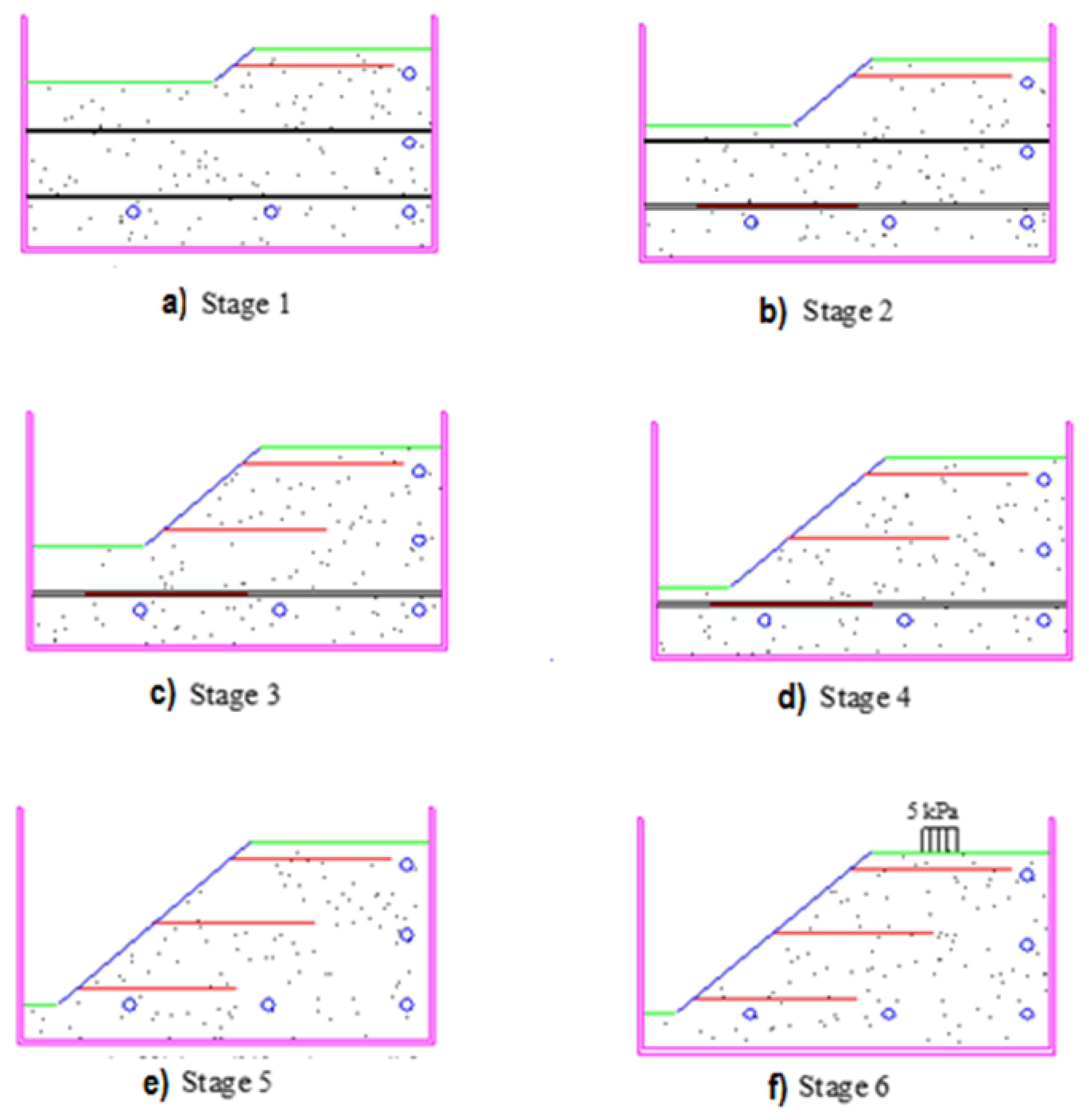




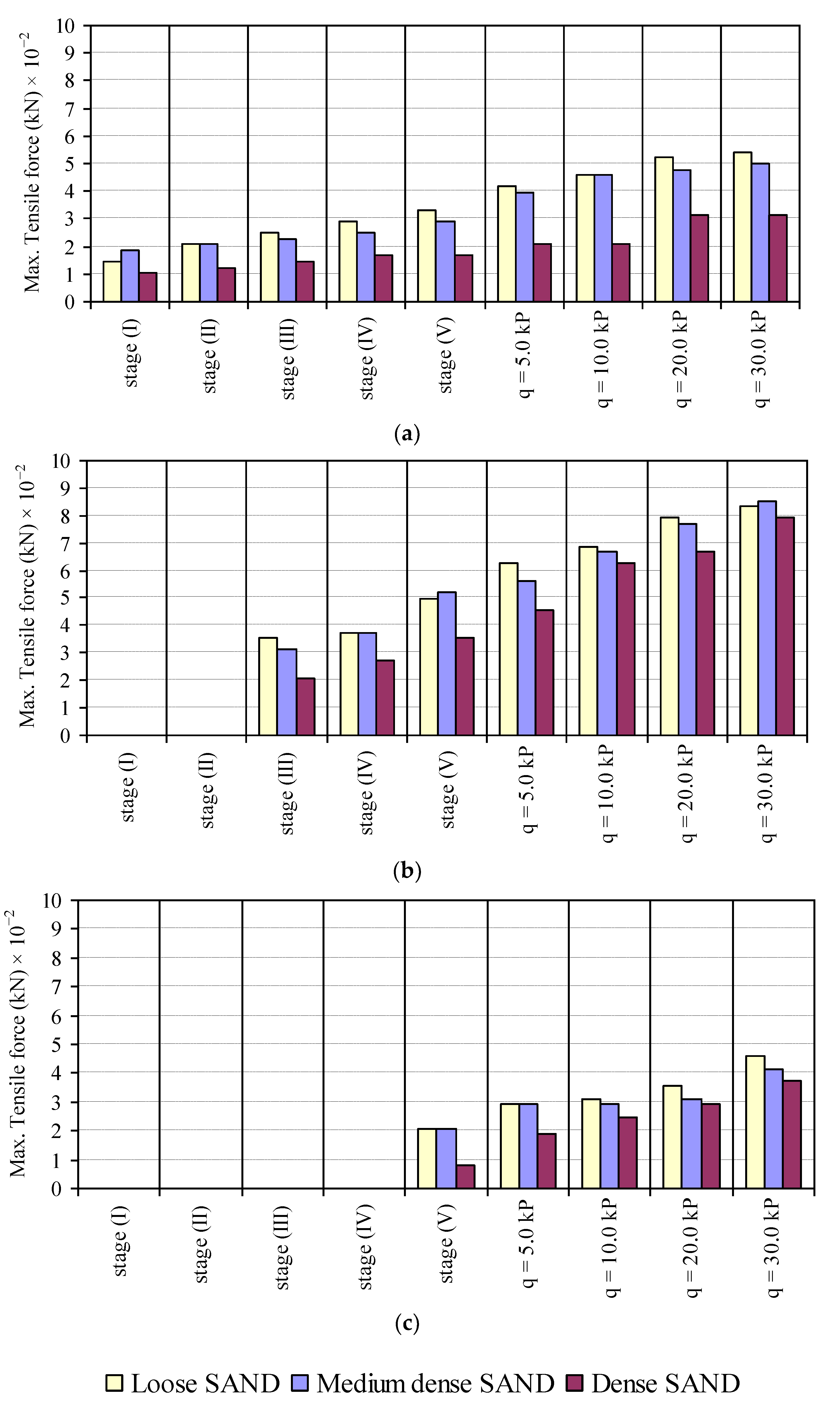
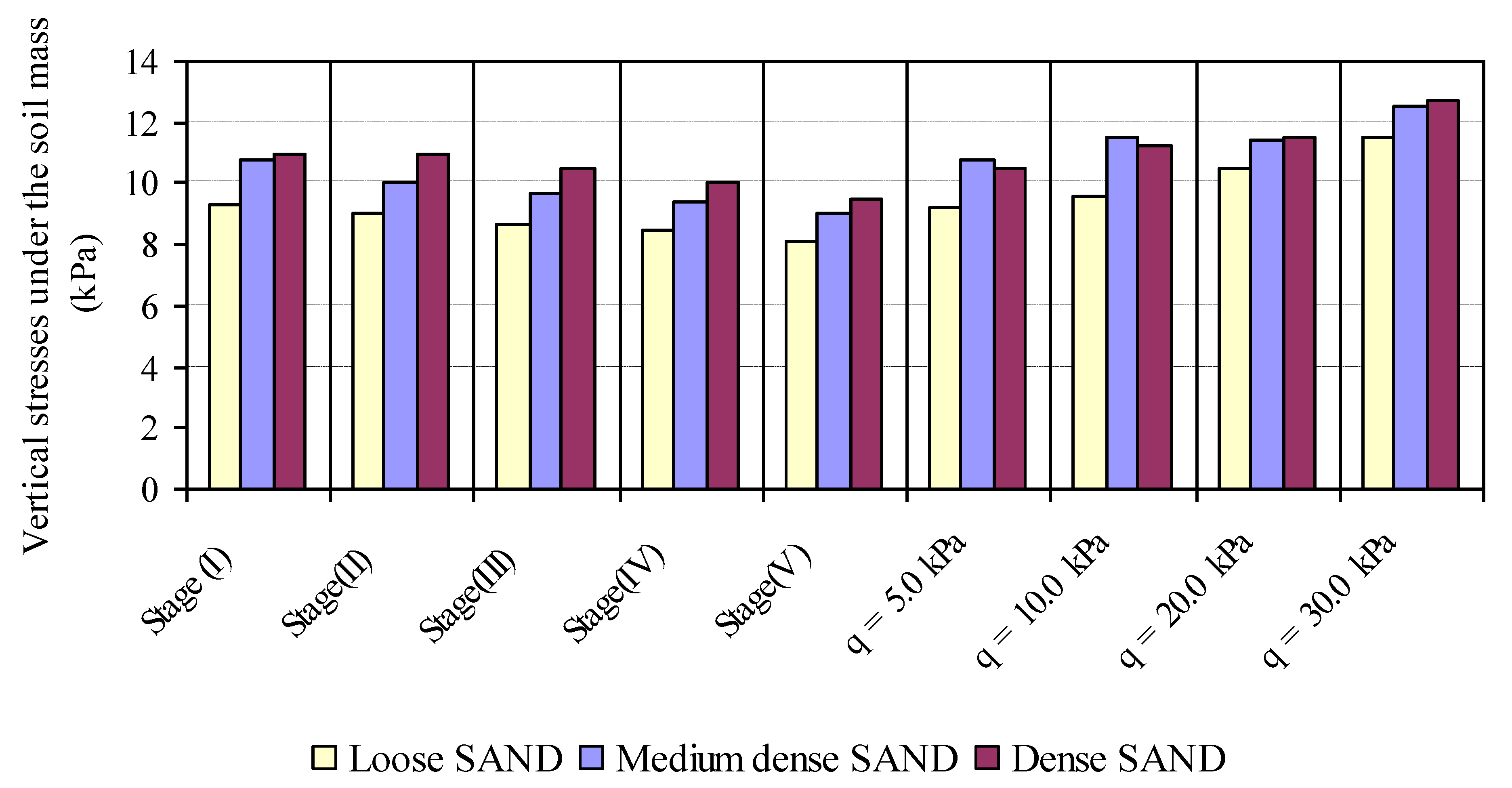
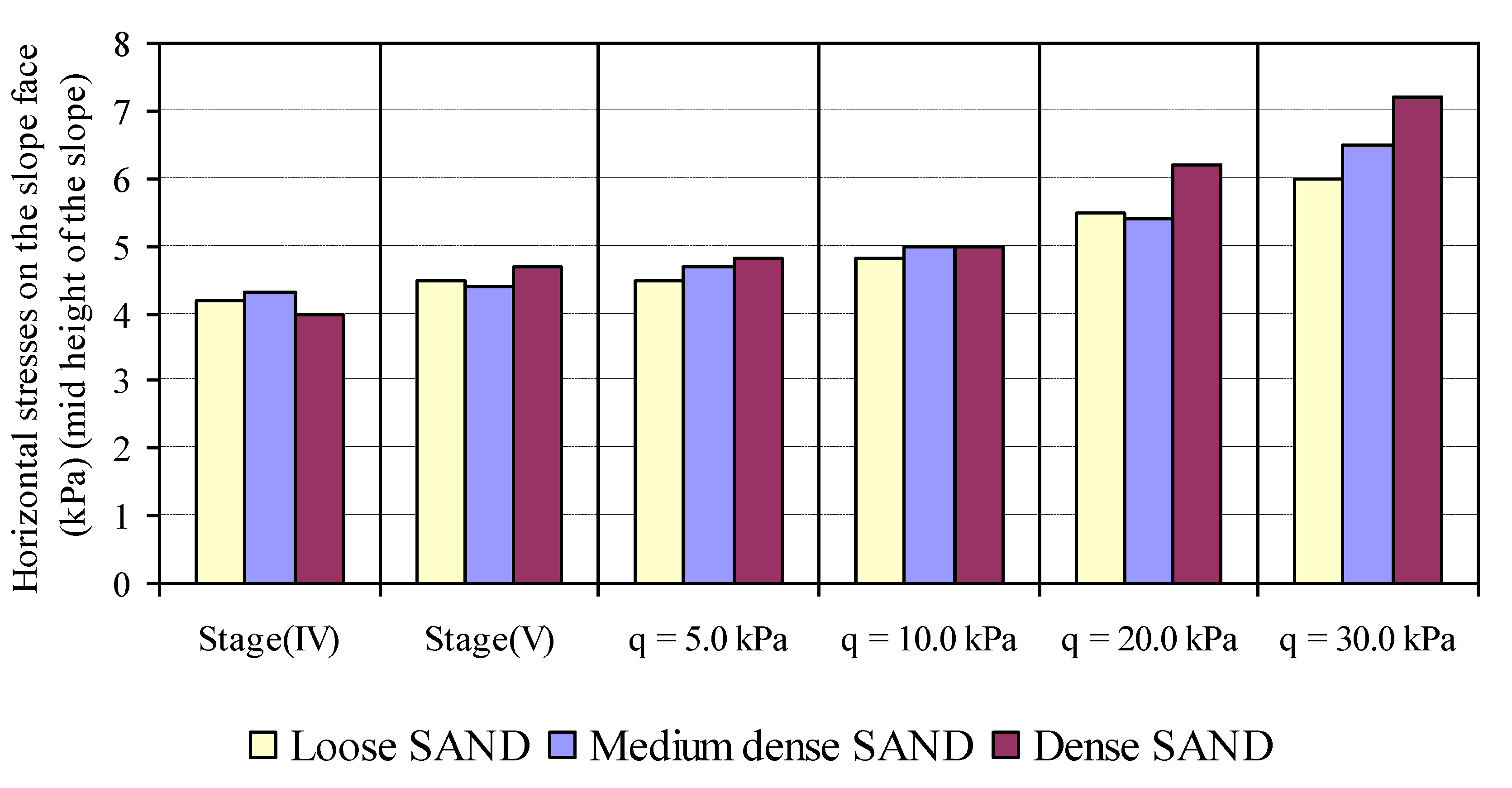
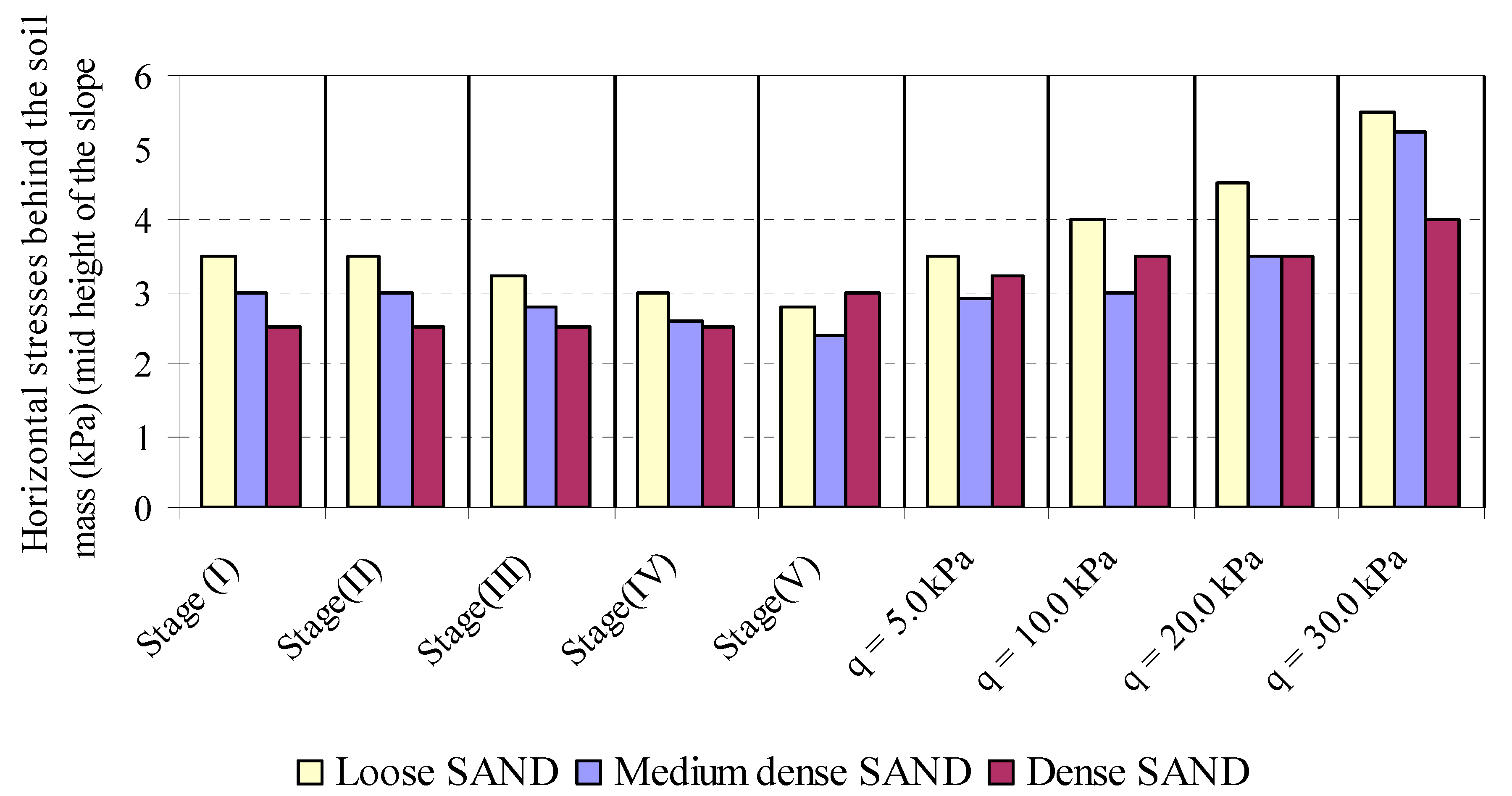

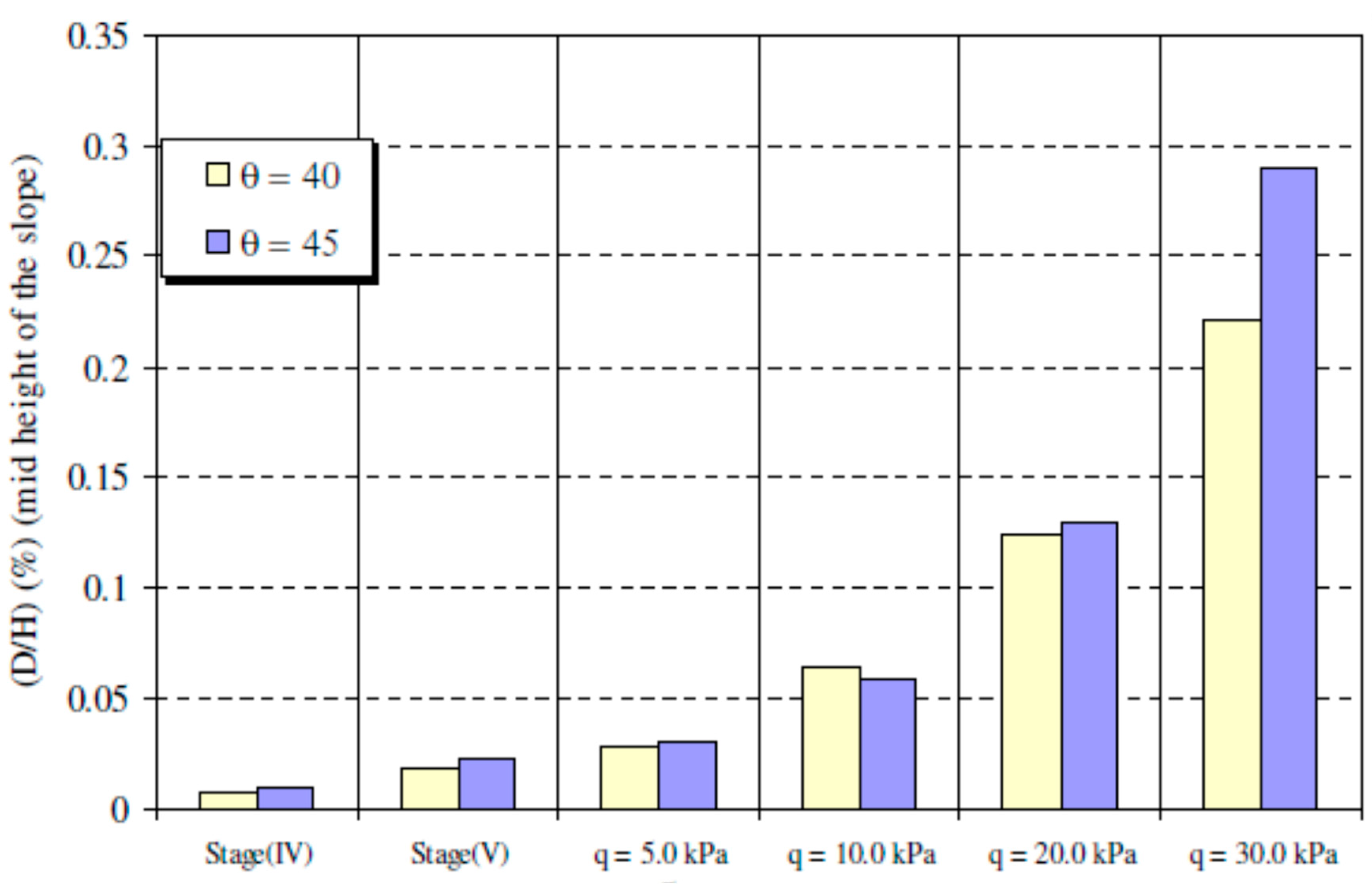
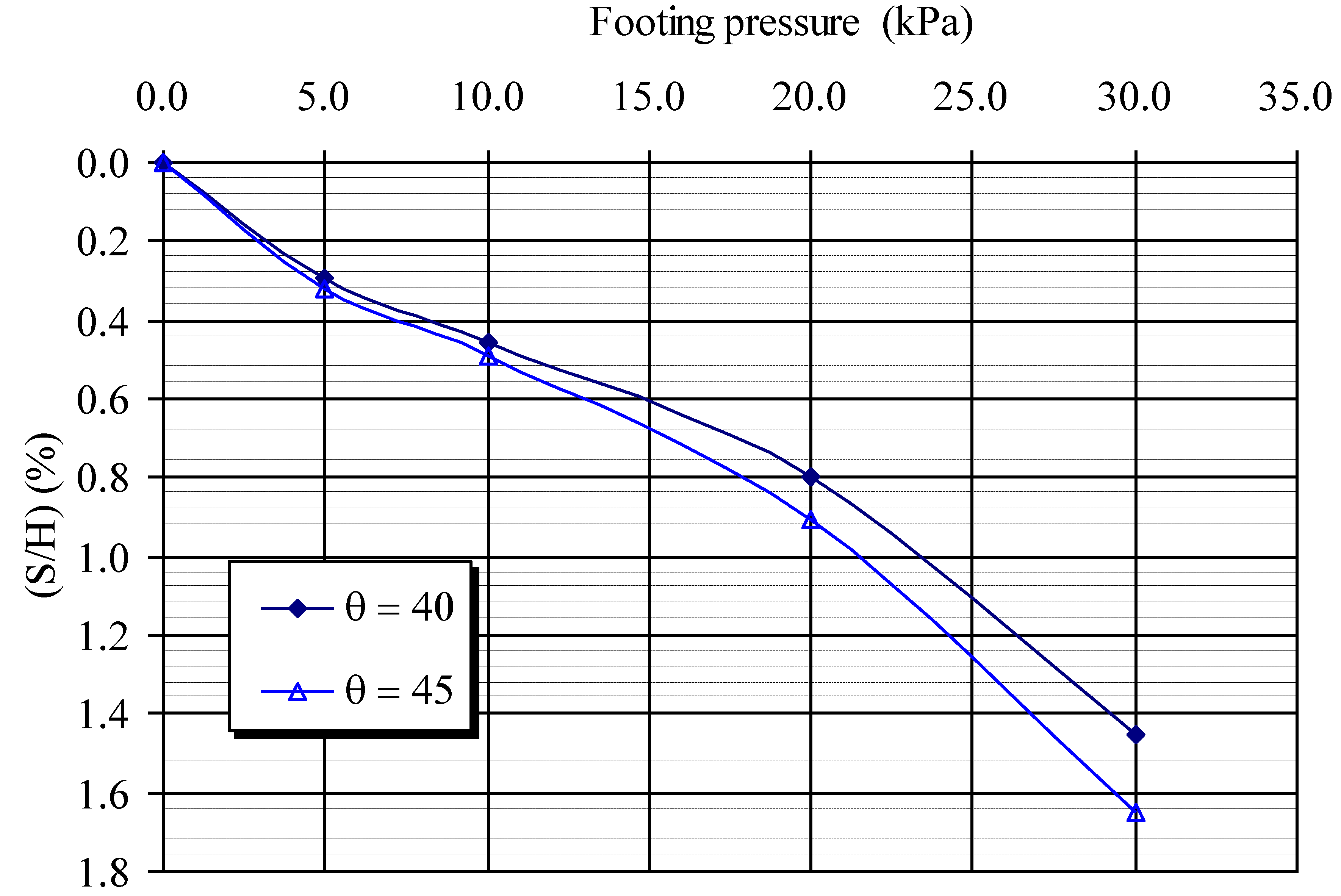
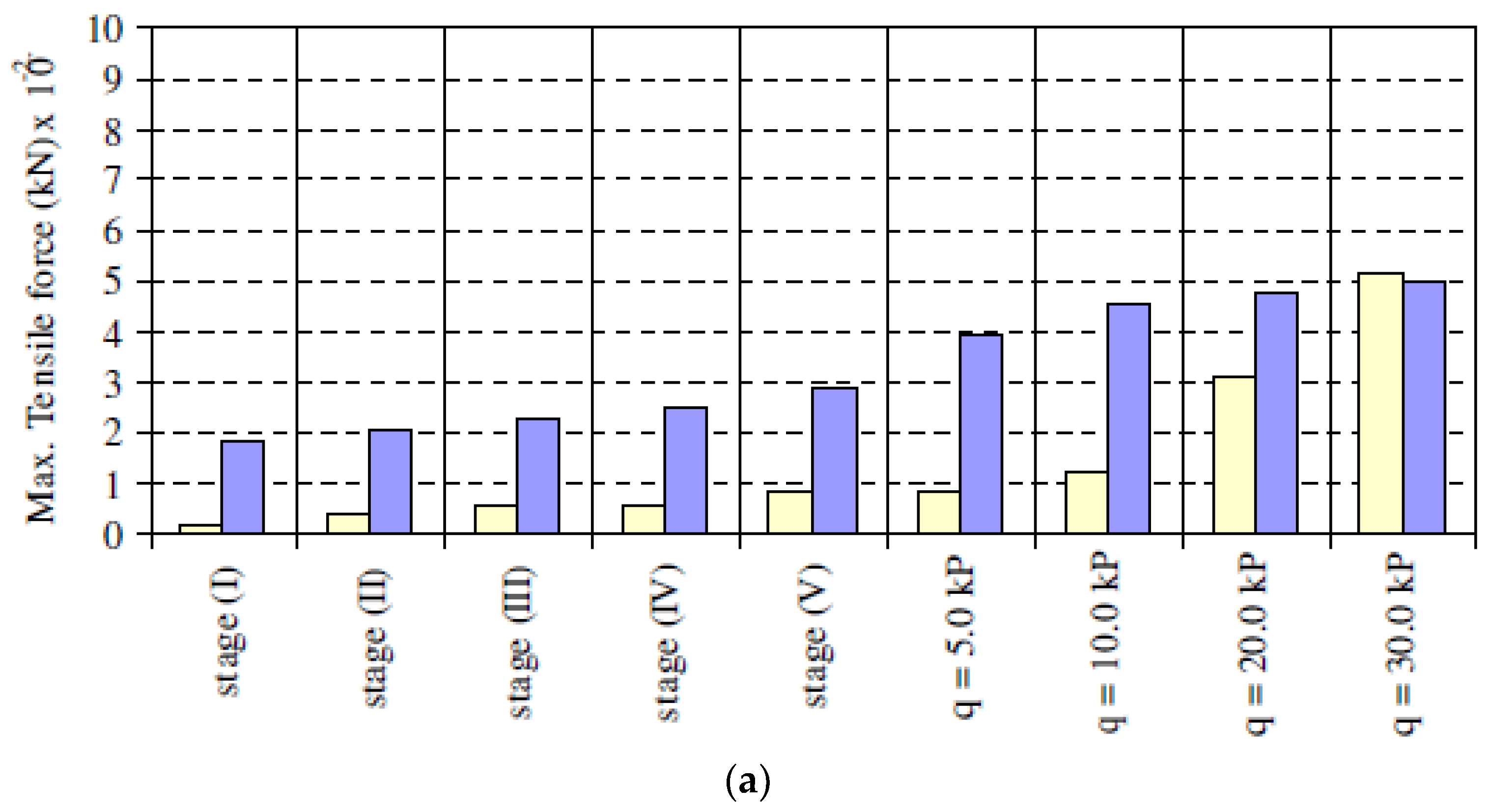

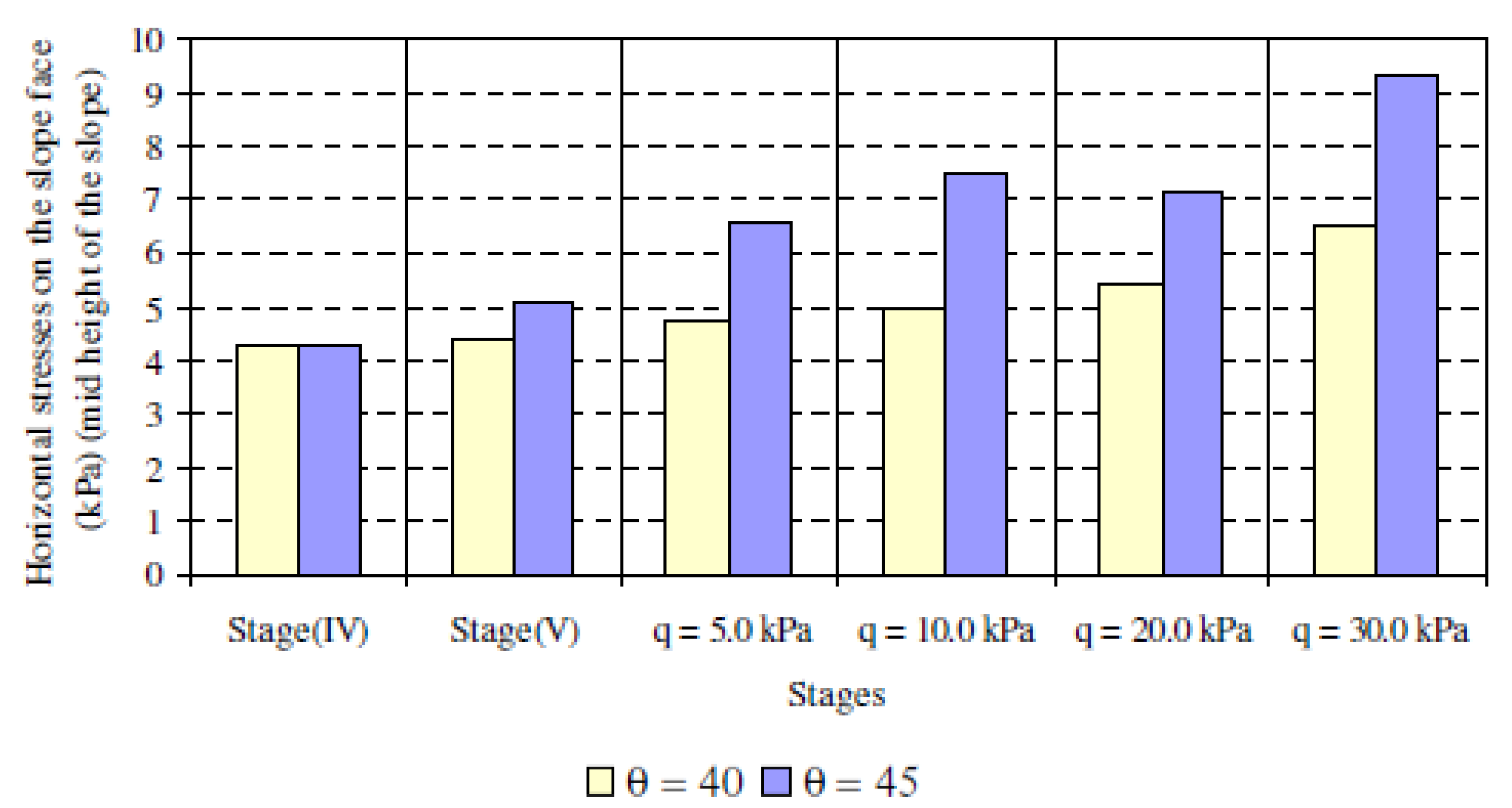
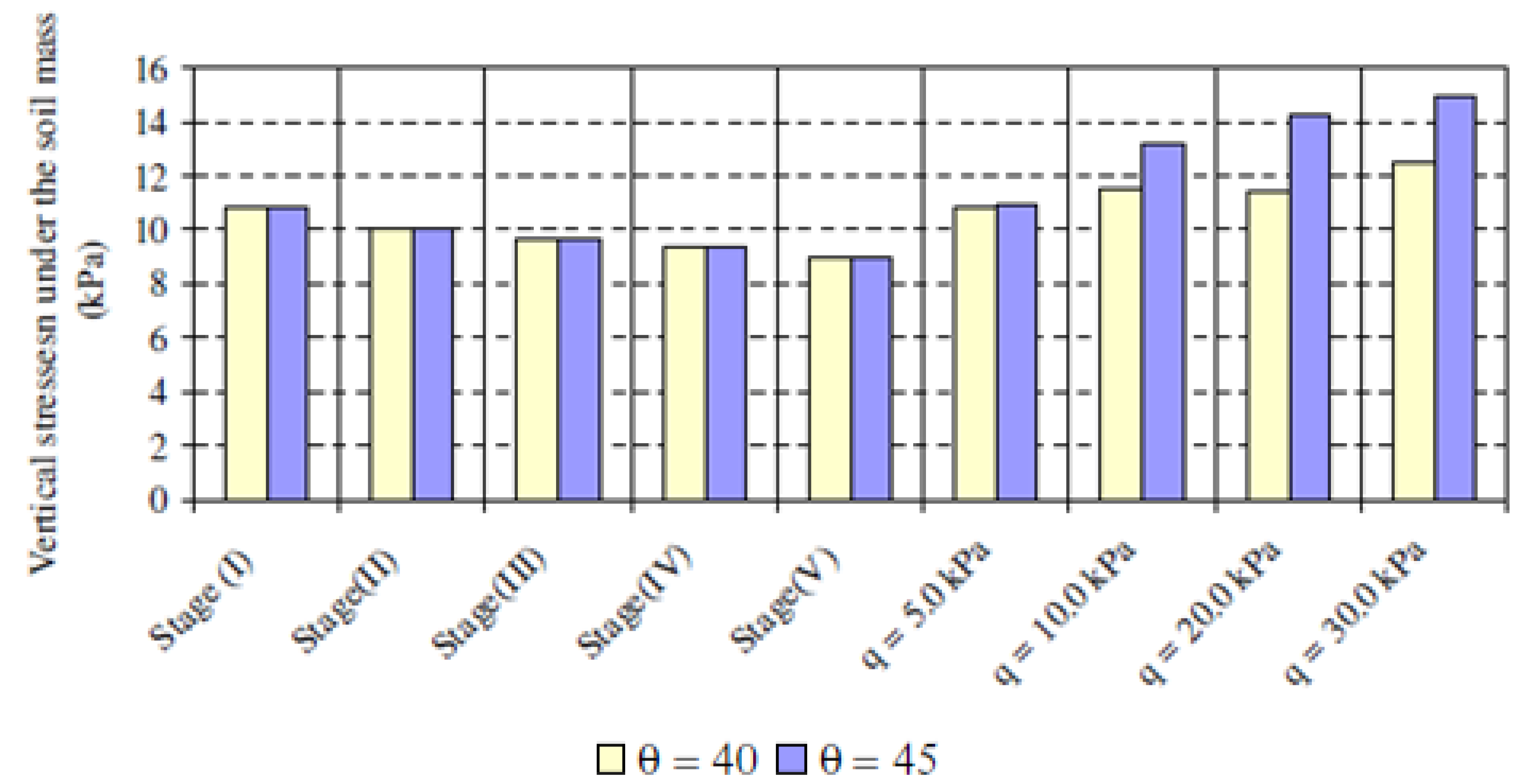

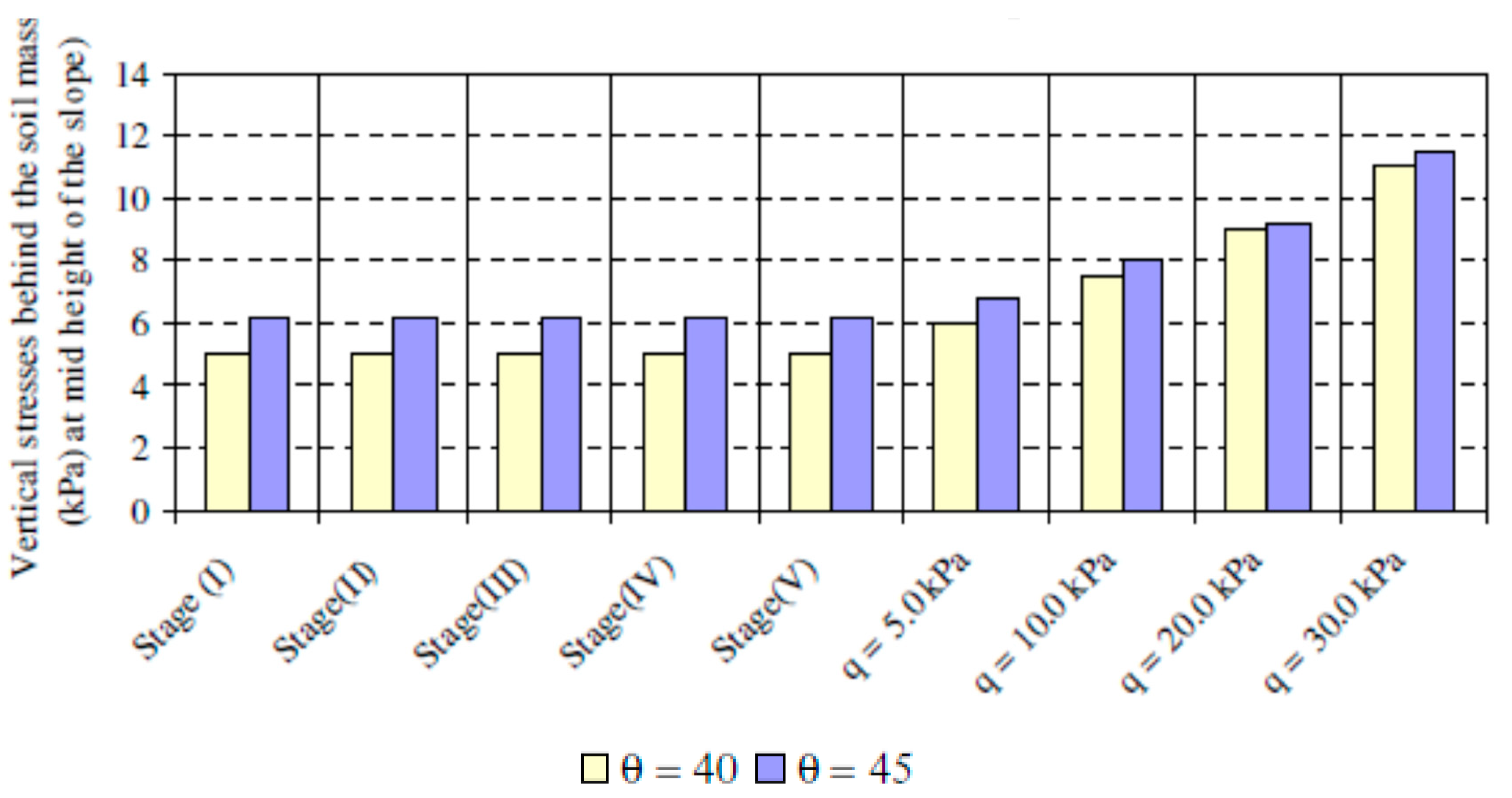
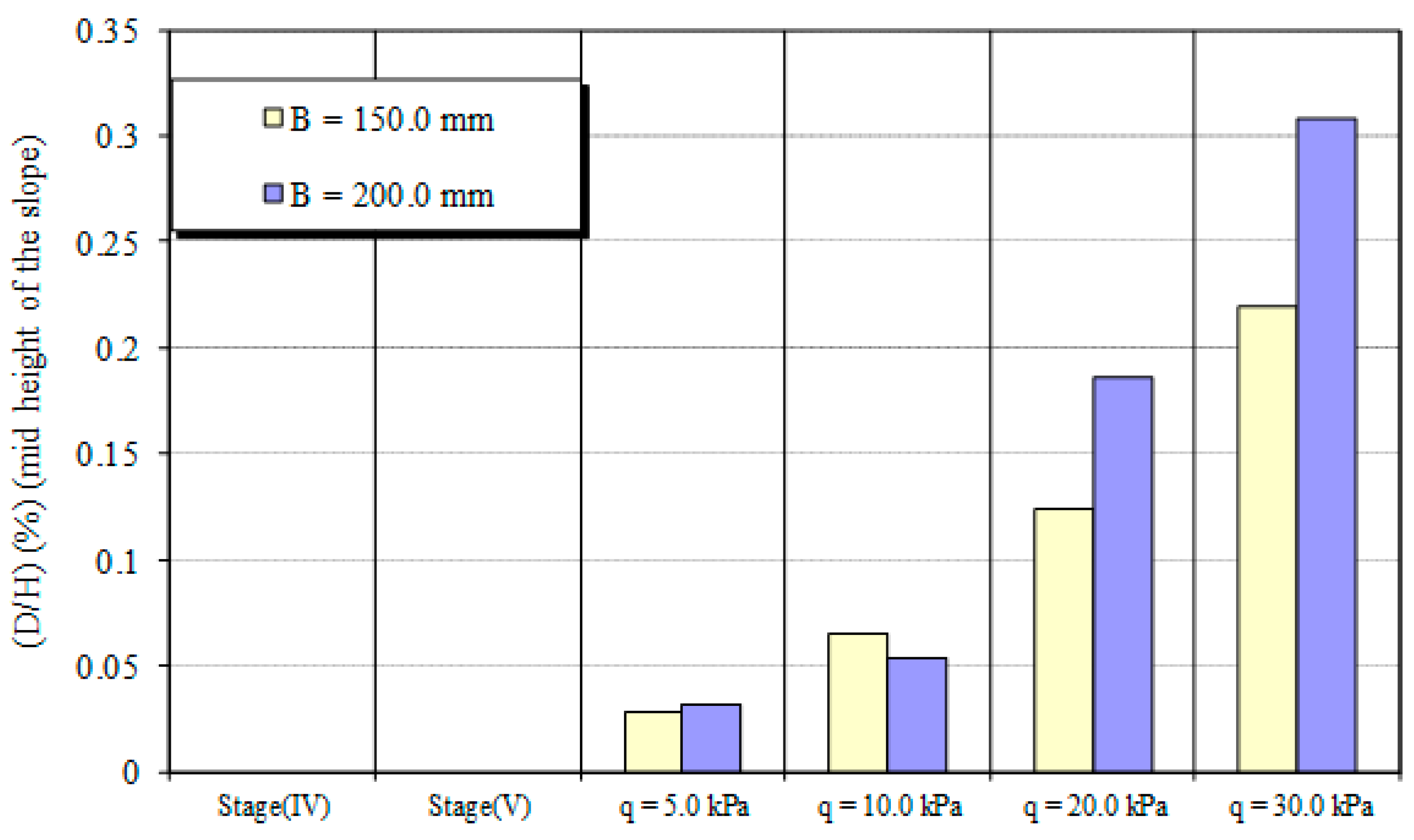
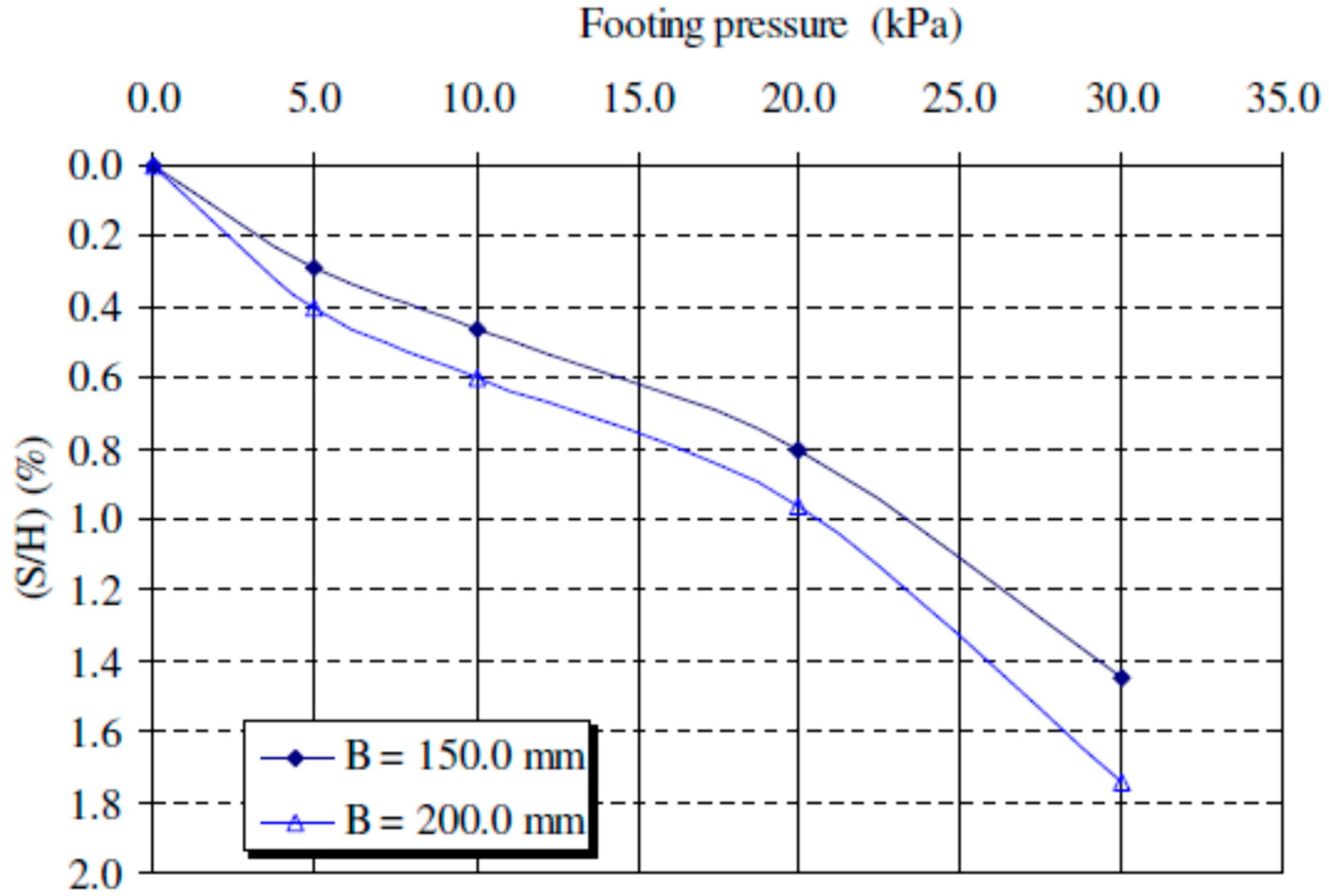

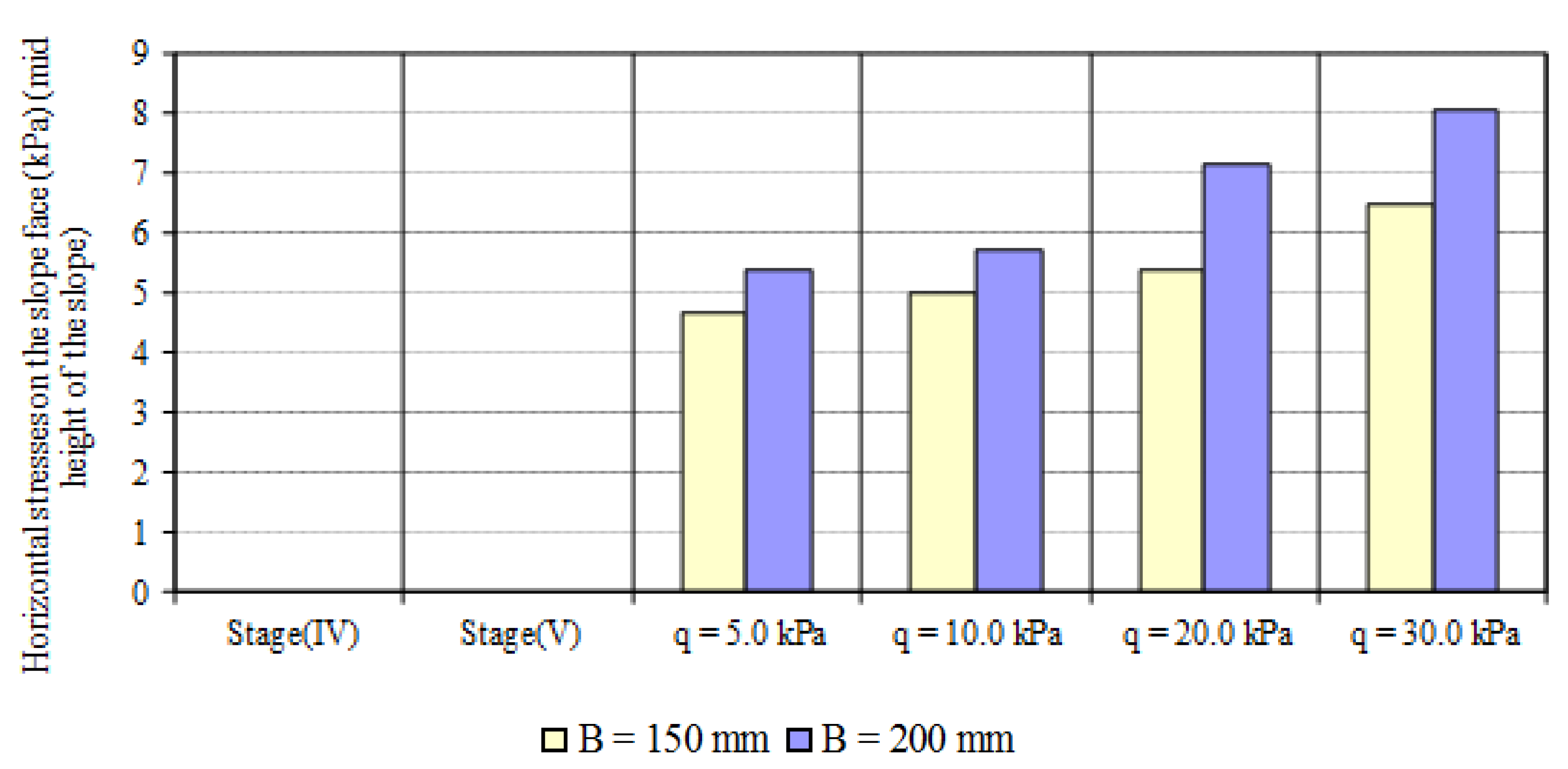
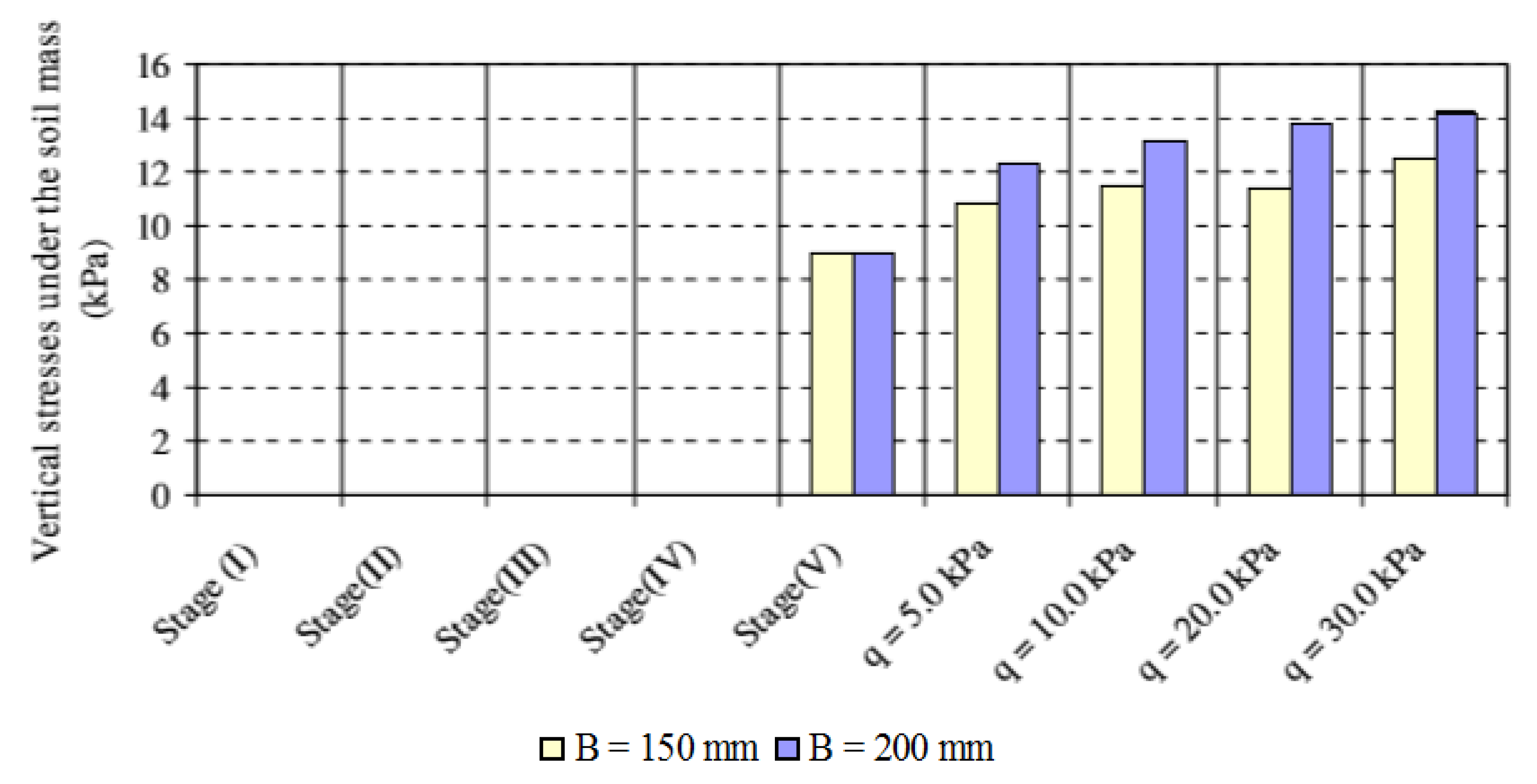
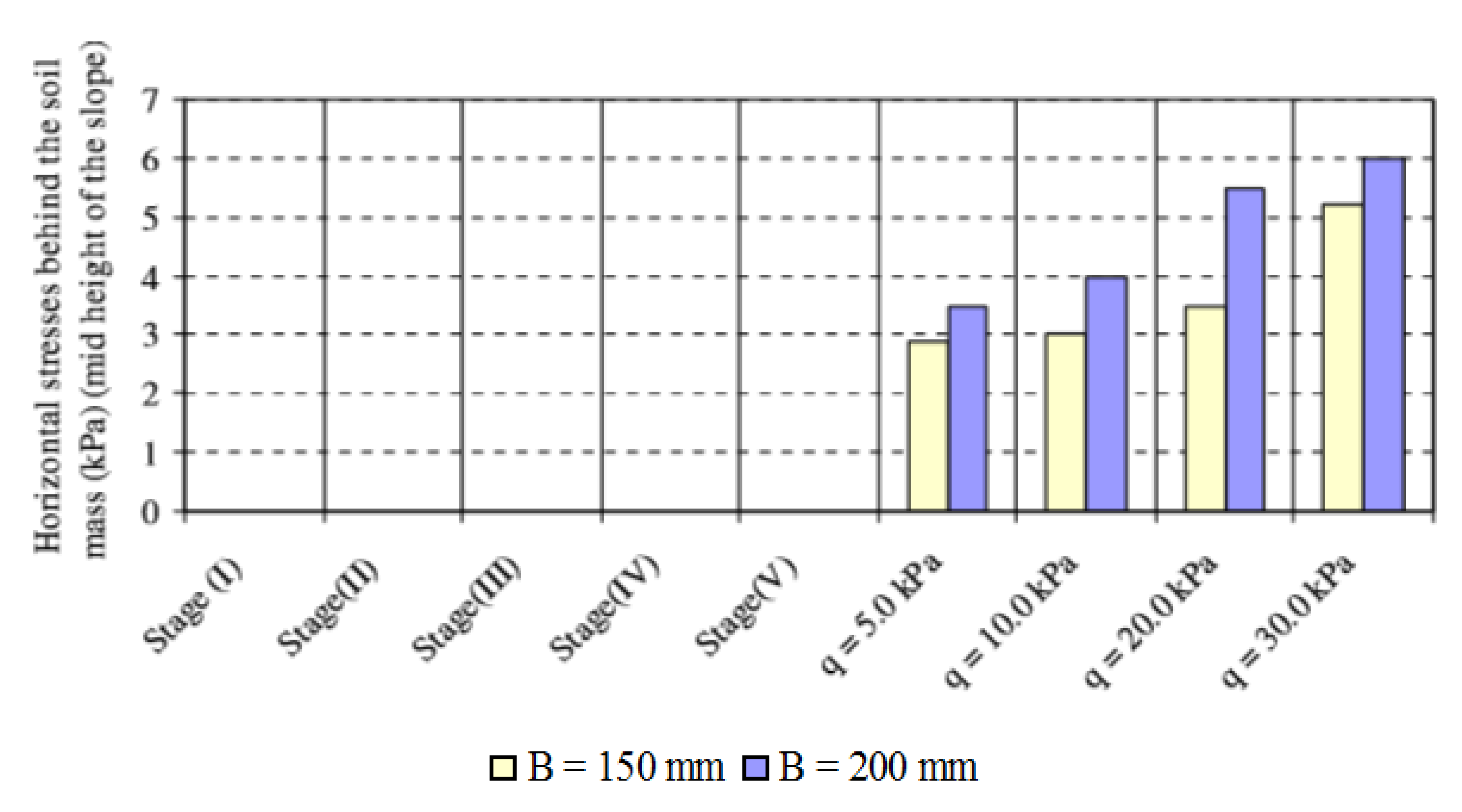

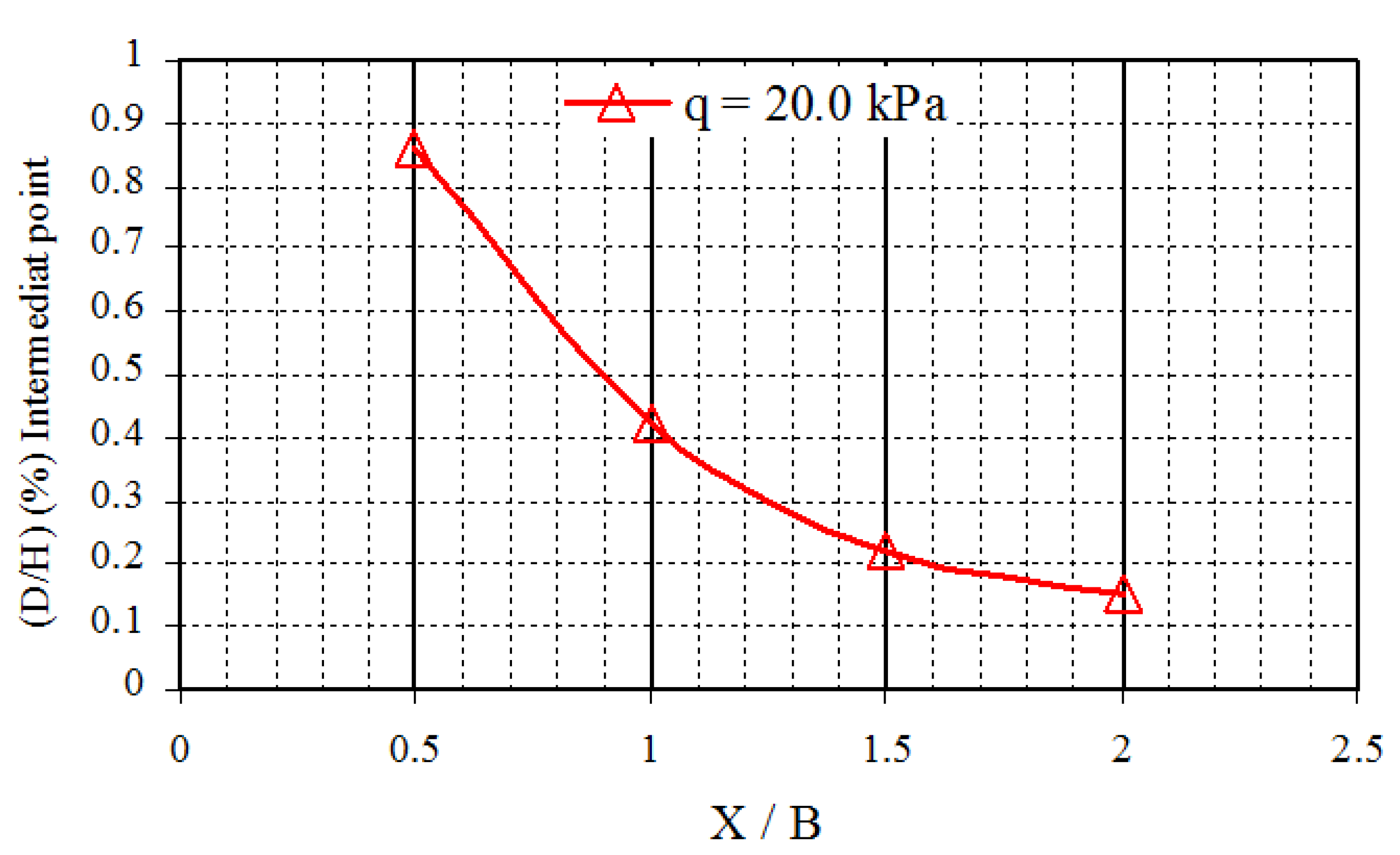
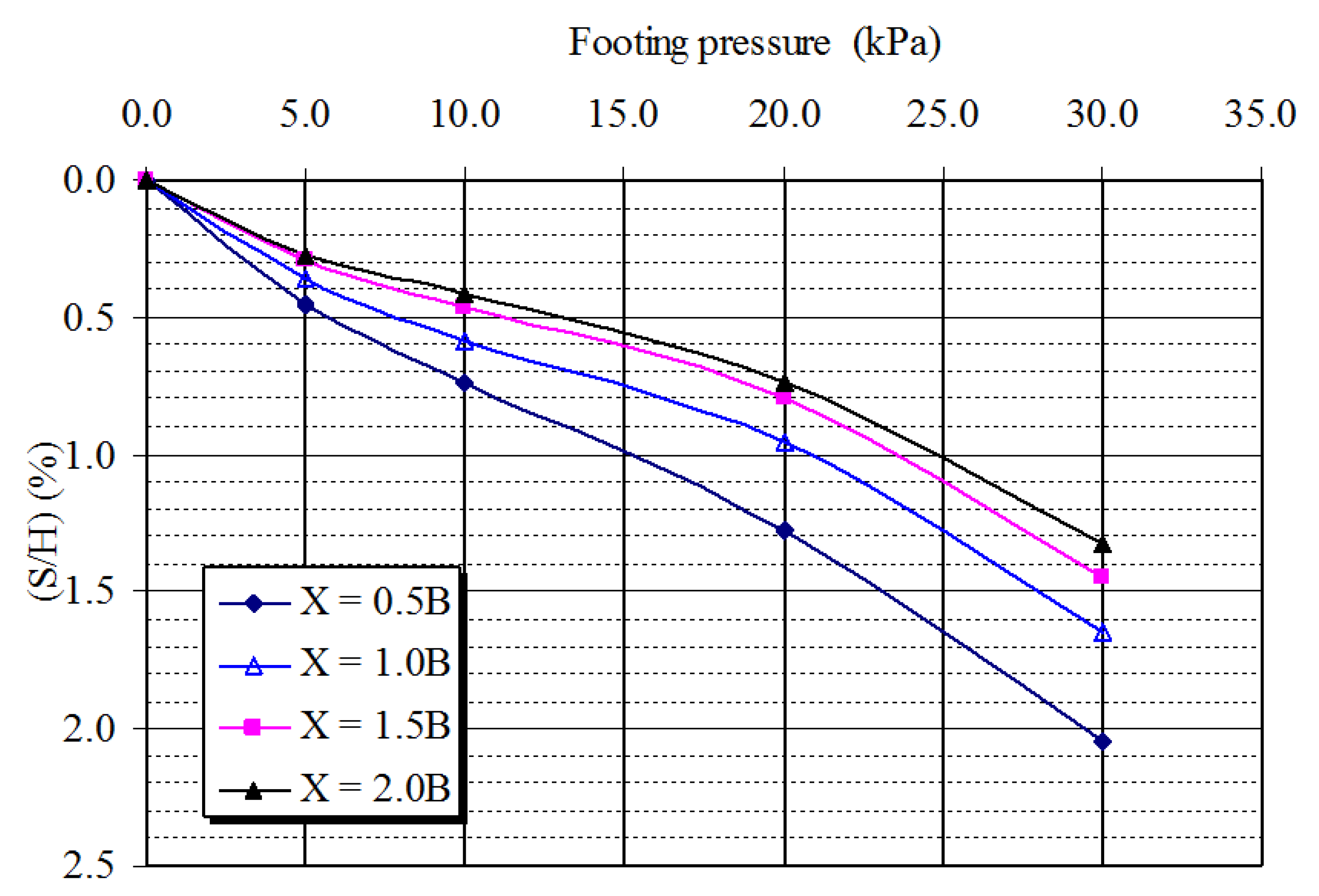
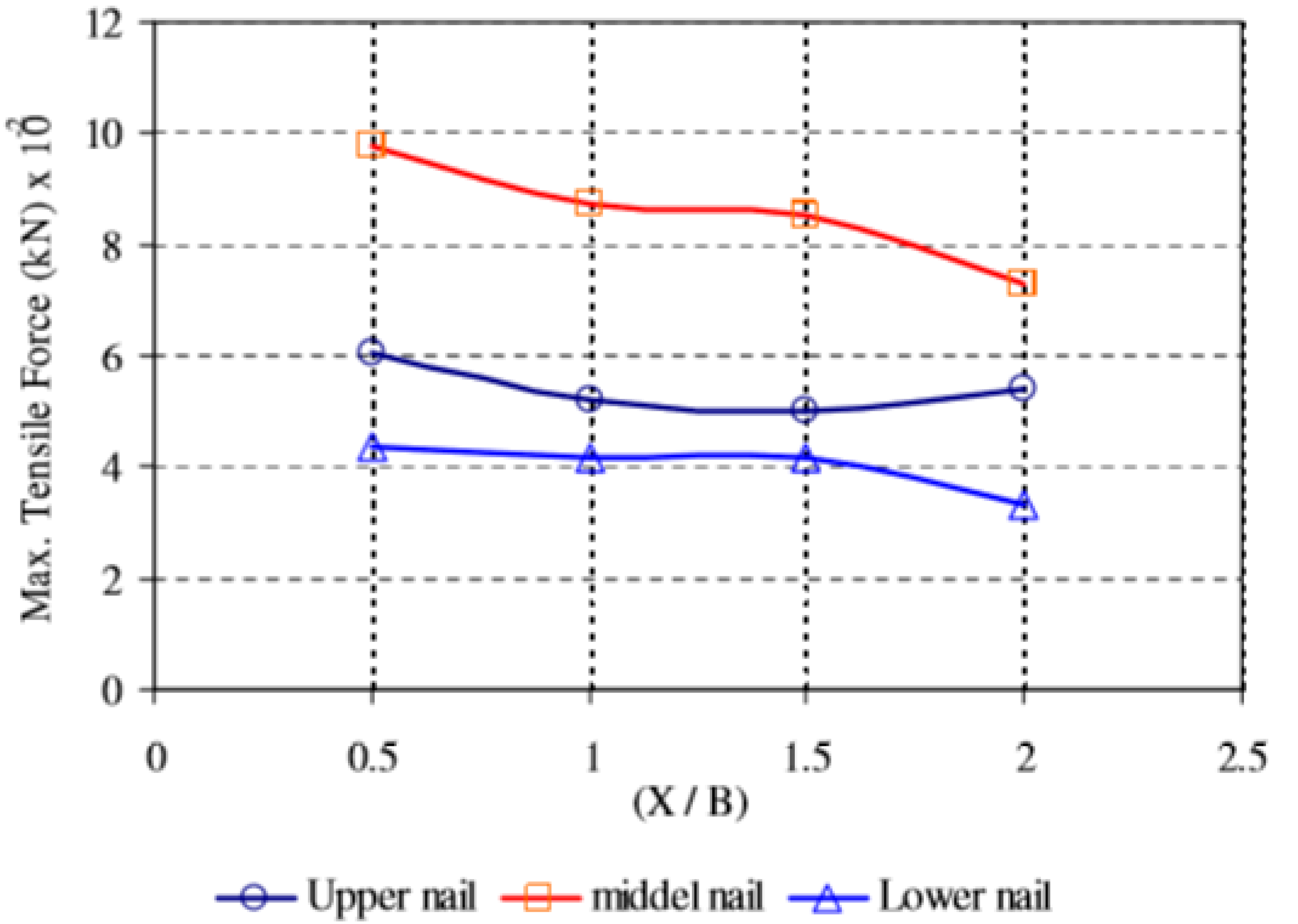
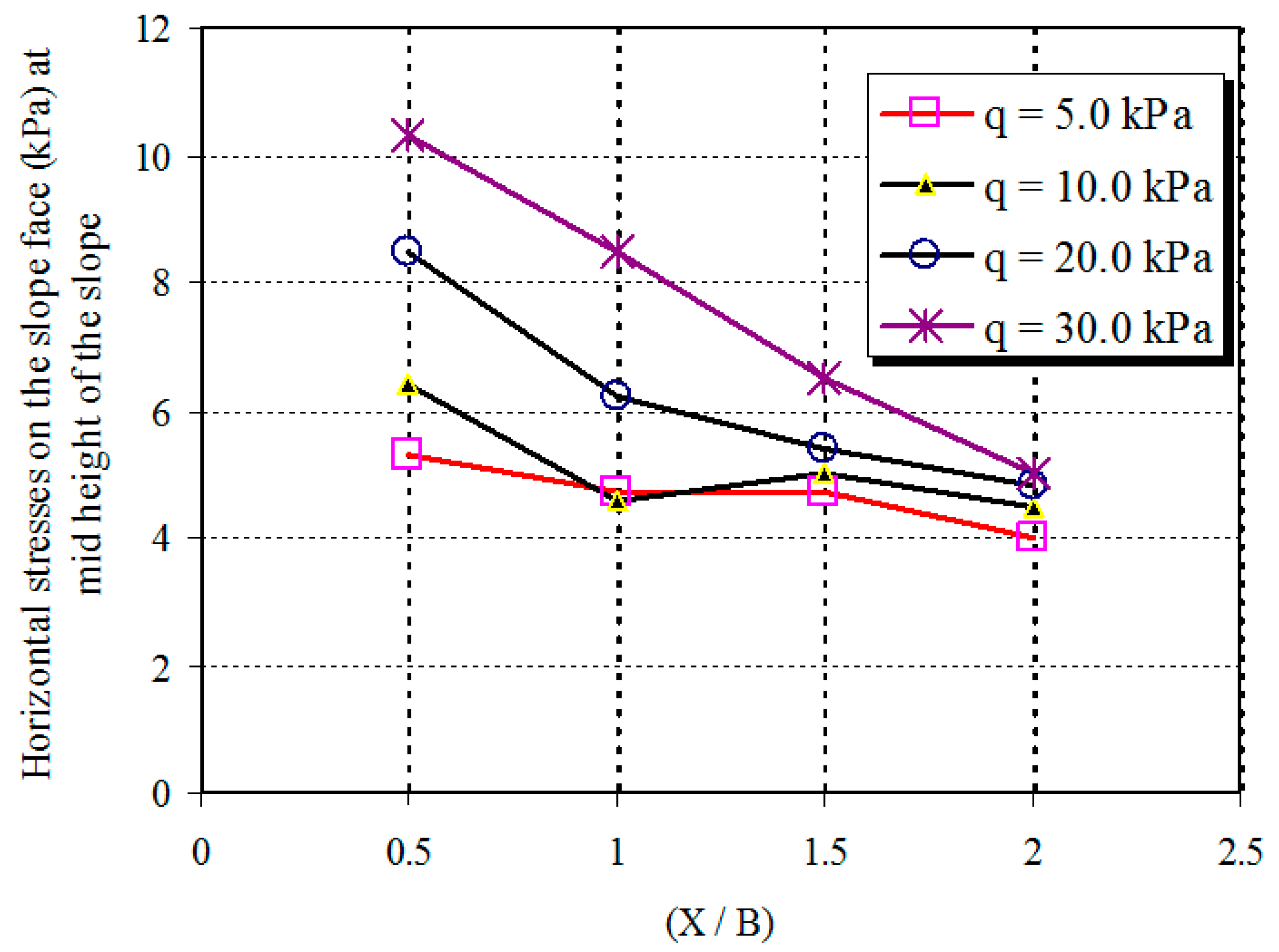


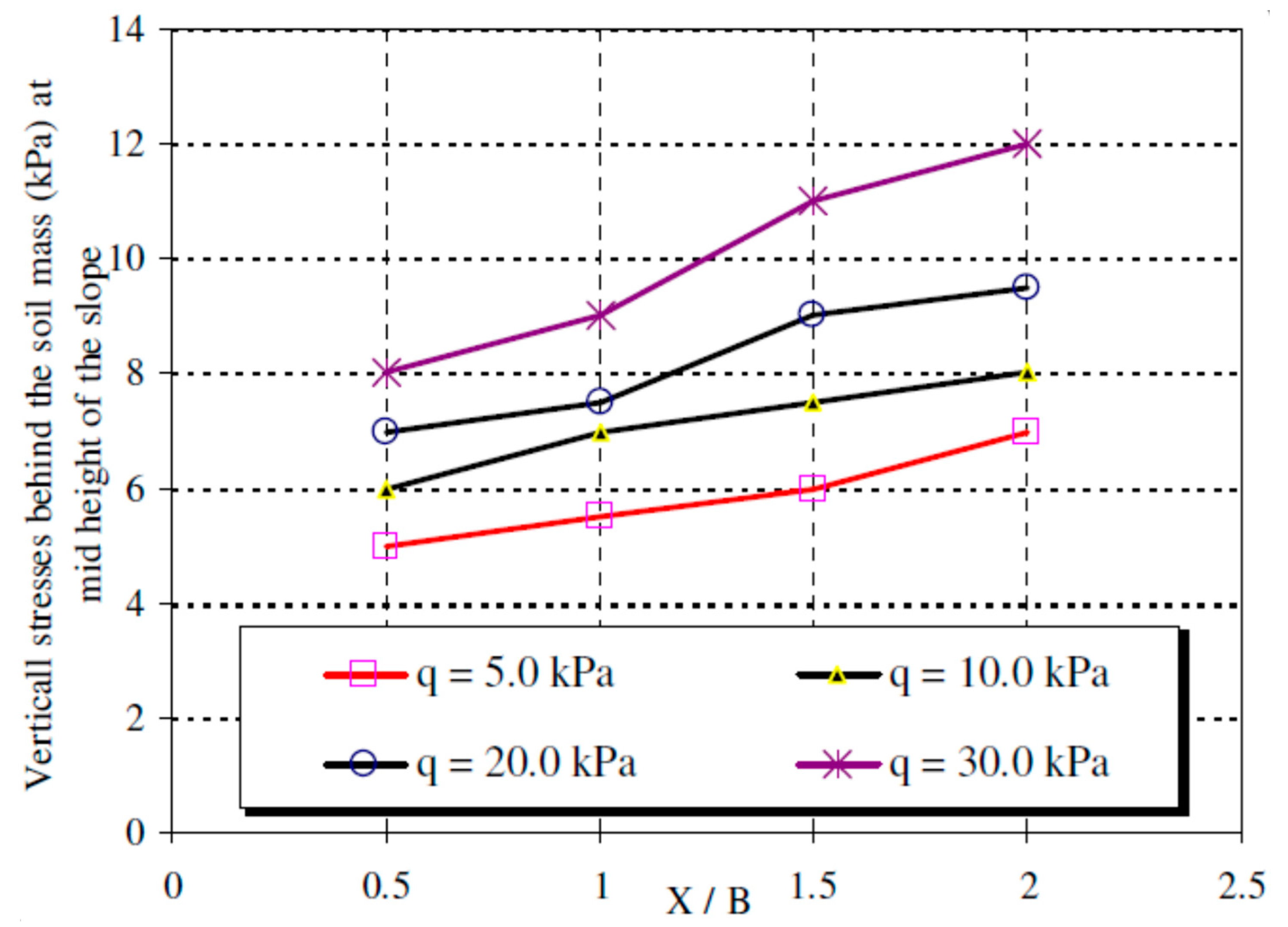
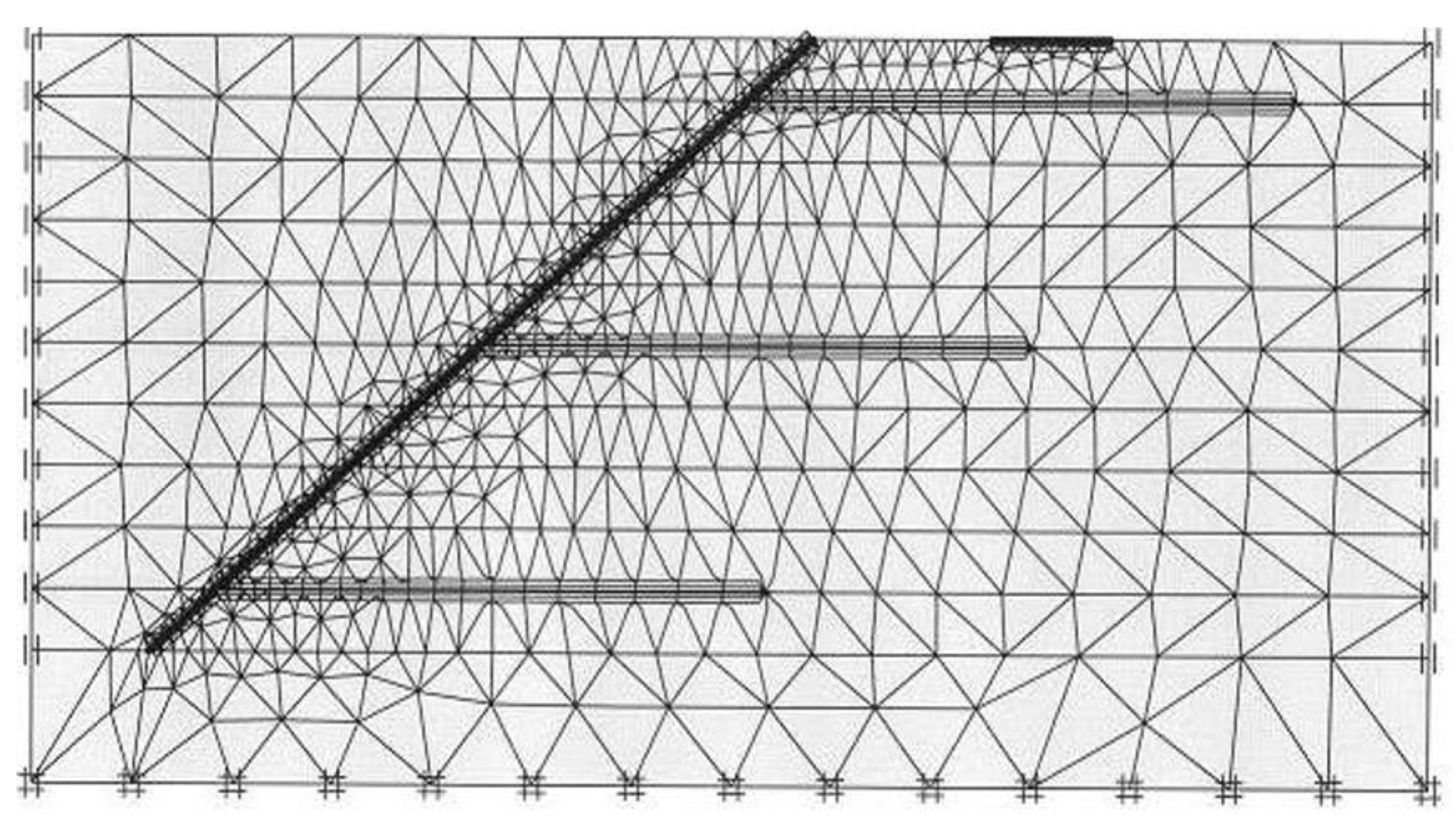


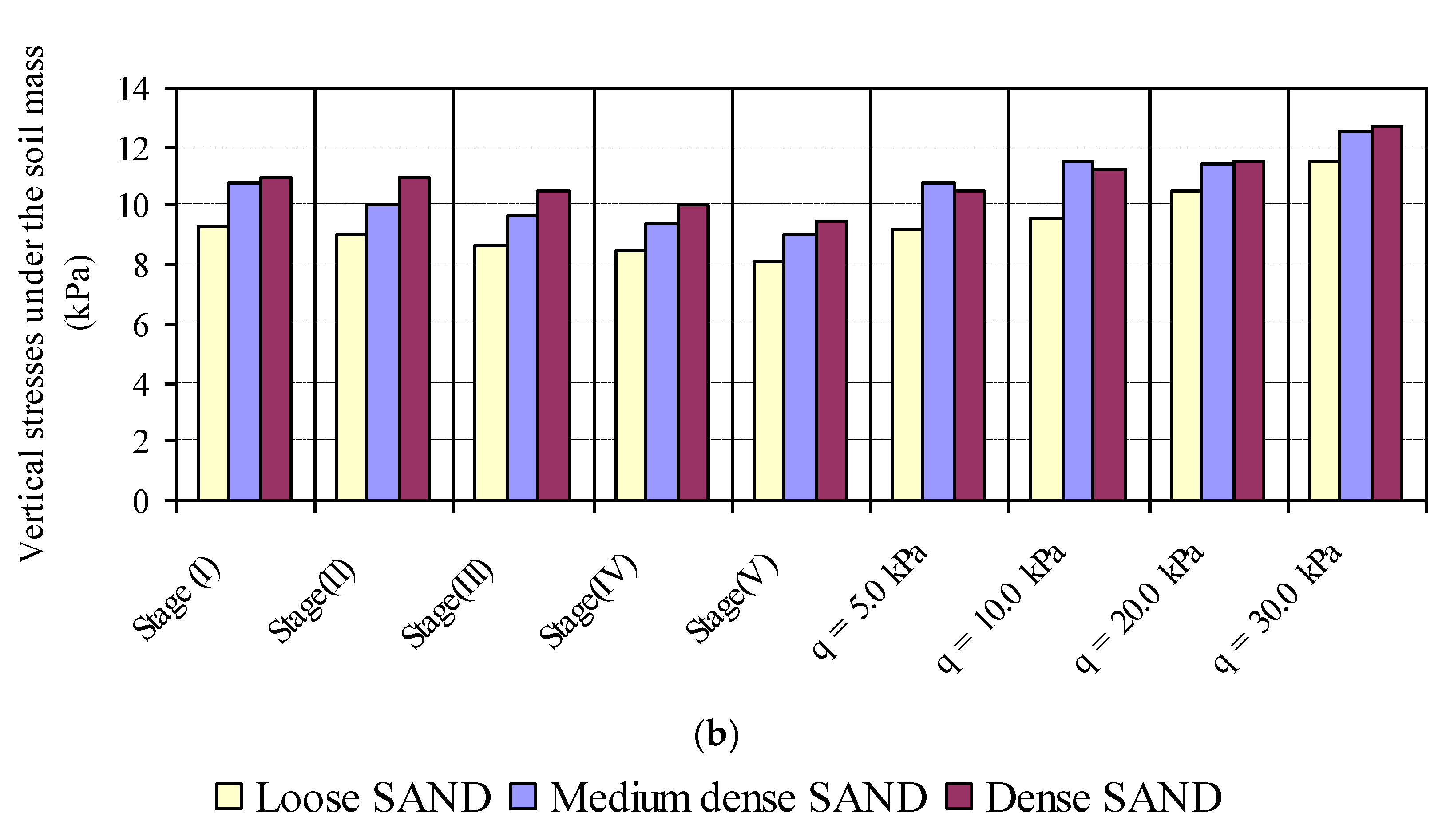
| Property | Value | Property | Value |
|---|---|---|---|
| % of clay | 0.00 | Coefficient of uniformity (Cu) | 1.99 |
| % of silt | 1.33 | Coefficient of gradation (Cu) | 1.00 |
| % of fine sand | 39.17 | Specific gravity (Gs) | 2.62 |
| % of medium sand | 58.63 | Minimum unit weight (γmin) (kN/m3) | 15.30 |
| % of coarse sand | 0.87 | Maximum unit weight (γmax) (kN/m3) | 17.80 |
| % of fine gravel | 0.00 | Minimum void ratio (emin) | 0.472 |
| Effective diameter (D10) mm | 0.126 | Maximum void ratio (emax) | 0.712 |
| Element | Length (mm) | Maximum Tensile Force (kN) | Strains at Ultimate Stress (µε) | Maximum Tensile Strength (kPa) | Young’s Modulus (kPa) | Flexural Rigidity, EI (kN/mm2) | Normal Stiffness, EA (kN/m) |
|---|---|---|---|---|---|---|---|
| 5 mm Steel Nails | 700.0 | 17.4 | 7625 | 8.8 × 105 | 21.2 × 107 | 6.51 × 10−3 | 4165.9 |
| Plate Element | Material | Width (mm) | Thickness (mm) | Young’s Modulus (kPa) | Bending Stiffness (kN/mm2) | Axial Stiffness (kN) |
|---|---|---|---|---|---|---|
| Footing | Steel | 150 | 22.0 | 21.2 × 107 | 188,186.6 | 4665.78 |
| Facing | Perspex Plate | 140 | 5.0 | 4200 | 0.04375 | 0.021 |
| Soil Type | Density (kN/m3) | Mohr-Coulomb Model | Plastic Straining Due to Primary Comp./Deviator Loading (Eoed)ref (kPa) | Elastic Unloading/Reloading | Stress-Dependent Stiffness (m) | ||||
|---|---|---|---|---|---|---|---|---|---|
| φ | C (kPa) | ψ | υ | (Eur)ref (kPa) | υur | ||||
| Loose sand (RD = 34%, e = 0.631) | 16.06 | 30 | 0.2 | 0 | 0.33 | 1327 | 3981 | 0.2 | 0.5 |
| Medium sand (RD = 48%, e = 0.597) | 16.41 | 34 | 0.2 | 4 | 0.31 | 1959 | 5877 | 0.2 | 0.5 |
| Dense sand (RD = 68%, e = 0.549) | 16.92 | 40 | 0.2 | 10 | 0.26 | 2632 | 7896 | 0.2 | 0.5 |
Publisher’s Note: MDPI stays neutral with regard to jurisdictional claims in published maps and institutional affiliations. |
© 2021 by the authors. Licensee MDPI, Basel, Switzerland. This article is an open access article distributed under the terms and conditions of the Creative Commons Attribution (CC BY) license (https://creativecommons.org/licenses/by/4.0/).
Share and Cite
Mohamed, M.H.; Ahmed, M.; Mallick, J. An Experimental Study of Nailed Soil Slope Models: Effects of Building Foundation and Soil Characteristics. Appl. Sci. 2021, 11, 7735. https://doi.org/10.3390/app11167735
Mohamed MH, Ahmed M, Mallick J. An Experimental Study of Nailed Soil Slope Models: Effects of Building Foundation and Soil Characteristics. Applied Sciences. 2021; 11(16):7735. https://doi.org/10.3390/app11167735
Chicago/Turabian StyleMohamed, Mahmoud H., Mohd Ahmed, and Javed Mallick. 2021. "An Experimental Study of Nailed Soil Slope Models: Effects of Building Foundation and Soil Characteristics" Applied Sciences 11, no. 16: 7735. https://doi.org/10.3390/app11167735
APA StyleMohamed, M. H., Ahmed, M., & Mallick, J. (2021). An Experimental Study of Nailed Soil Slope Models: Effects of Building Foundation and Soil Characteristics. Applied Sciences, 11(16), 7735. https://doi.org/10.3390/app11167735






